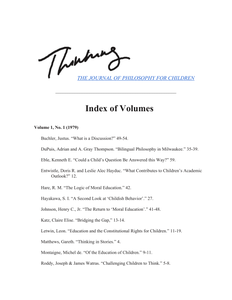The journal was a forum for the work of both theorists and practitioners of philosophical practice with children, and published such work in all forms, including philosophical argument and reflection, classroom transcripts, curricula, empirical research, and reports from the field. The journal also maintained a tradition in publishing articles in the hermeneutics of childhood, a field of intersecting disciplines including cultural studies, social history, philosophy, art, literature and psychoanalysis.
DOCUMENT

In secondary school philosophy classes students learn to reason critically about social and scientific issues. This study examined the effects of a whole-class, teacher-led philosophy classroom dialogue intervention on students’ value-loaded critical thinking. Value-loaded critical thinking is logically consistent, self-reflective reasoning focused on making moral value-judgments about what is right to believe or do. In a quasi-experimental study (N = 437 students) with a pre-test post-test design, we investigated whether engaging in classroom dialogues in which the teachers implemented five design principles for promoting value-loaded critical thinking and transfer thereof, positively affected students’ (n = 150) value-loaded critical thinking in transfer tasks. The results were compared to two comparison conditions: students (n = 149) who participated in regular teacher-led philosophy classroom dialogues and students (n = 145) who followed a regular 10th-grade curriculum without philosophy classes. Results showed that students in the intervention condition outperformed students in both comparison conditions on referring to moral values. Regarding critical reasoning, we only found significant effects compared to the students who followed the regular 10th-grade curriculum. Findings indicate that a specifically designed dialogic intervention can enhance students’ capacities in value-loaded critical thinking.
DOCUMENT

Recently several attempts were undertaken to unite the field of metaphor studies, trying to reconcile the conceptual/cognition and linguistic/discourse approaches to metaphor (Hampe, 2017b). The dynamic view of metaphor espoused by amongst others Gibbs (2017a) as a way to unify the field of metaphor studies is said to converge on findings and theoretical predictions found in cognition and discourse approaches. The author argues this focus on dynamical models to explain the multi-scale socio-cognitive aspects of metaphor as an emergent phenomenon is not robust enough. Complexity and dynamical systems are merely a modelling technique to deploy theory for empirical testing of hypotheses; a dynamic view of metaphor needs a coherent background theory to base its dynamic modelling of metaphor in action on (Chemero, 2009). I argue that it can be successfully based on the ecological-enactive framework available within the modern paradigm of 4E cognitive science. This framework makes possible explanation of both 'lower' cognition and 'higher' cognition emerging in the interaction of an organism with its environment. In addition, I sketch how recent theoretical insights from ecological-enactivism (Baggs and Chemero, 2018) concerning Gibson's notion of environment apply to the attempted unification of the field of metaphor studies. I close by suggesting how an understanding of metaphor as an ecological affordance of the socio-cultural environment can provide a rich basis for empirical hypotheses within a dynamical science of metaphor.
LINK